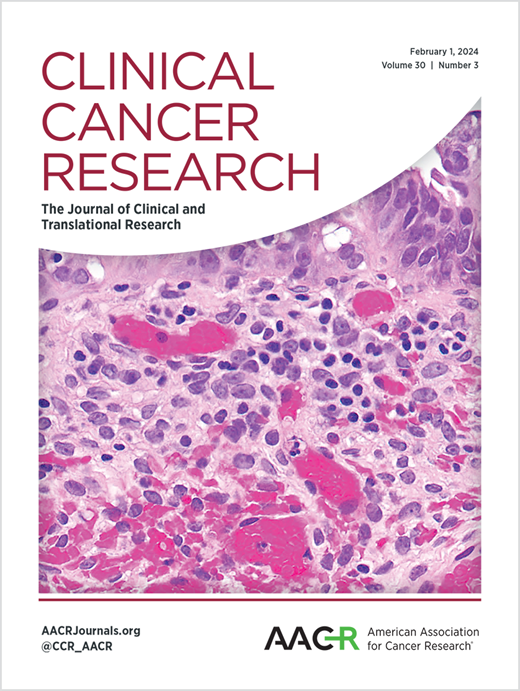First-in-Human Phase 1/2 Study of INCAGN01876, a Glucocorticoid-Induced Tumor Necrosis Factor Receptor Agonist, in Patients with Advanced or Metastatic Solid Tumors.
IF 10
1区 医学
Q1 ONCOLOGY
引用次数: 0
Abstract
BACKGROUND Glucocorticoid-induced tumor necrosis factor receptor-related protein (GITR) agonism in T cells may potentiate antitumor immunity responses to immune checkpoint blockade therapy. This first-in-human, phase 1/2 dose escalation/expansion study assessed INCAGN01876, a humanized GITR targeting agonistic monoclonal antibody, for advanced solid tumors (NCT02697591). METHODS Dose was escalated 0.03 to 20 mg/kg Q2W; flat doses of 400 mg Q4W and 300 mg Q2W were also evaluated. The primary objective was safety/tolerability; secondary objectives were pharmacokinetics and preliminary efficacy; exploratory objectives were immunogenicity, GITR occupancy, and immune biomarker assessment. RESULTS Among 100 patients enrolled (prior anti-PD-1/PD-L1 therapy, 47%; most common tumors: colorectal [19%]; melanoma [14%]); 2% had one dose-limiting toxicity (grade 4 hypoxia; grade 3 pleurisy). Maximum tolerated dose was not reached. Treatment-related adverse events (TRAEs) occurred in 69% of patients, most frequently fatigue (17%) and pruritus (14%); 10% had grade ≥3 TRAEs, most commonly fatigue (3%); 23% reported immune-related AEs, most frequently generalized pruritus and generalized rash (7% each). Doses ≥5 mg/kg Q2W resulted in full receptor occupancy at trough. INCAGN01876 elicited changes in immune parameters in some patients, including variable peripheral regulatory T-cell (Treg) depletion and cytokine upregulation. Two patients achieved confirmed partial responses; one with appendiceal mucinous carcinoma, and another with melanoma previously treated with pembrolizumab and glembatumumab; 36% of patients had disease control. CONCLUSION INCAGN01876 was generally well tolerated; fatigue was the most frequent TRAE. INCAGN01876 elicited transient and variable Treg depletion and limited antitumor activity. Future studies will explore combinatorial approaches.INCAGN01876是一种糖皮质激素诱导的肿瘤坏死因子受体激动剂,用于晚期或转移性实体瘤患者的首次人体1/2期研究。
糖皮质激素诱导的肿瘤坏死因子受体相关蛋白(GITR)在T细胞中的激动作用可能增强对免疫检查点阻断治疗的抗肿瘤免疫反应。这项首次人体1/2期剂量递增/扩展研究评估了INCAGN01876,一种人源GITR靶向激动性单克隆抗体,用于晚期实体瘤(NCT02697591)。方法剂量递增0.03 ~ 20mg /kg Q2W;还评估了400 mg Q4W和300 mg Q2W的平剂量。主要目标是安全性/耐受性;次要目标是药代动力学和初步疗效;探索目标是免疫原性、GITR占用率和免疫生物标志物评估。结果在入选的100例患者中(既往抗pd -1/PD-L1治疗,47%;最常见肿瘤:结直肠[19%];黑色素瘤[14%]);2%有一次剂量限制性毒性(4级缺氧;三级胸膜炎)。未达到最大耐受剂量。69%的患者发生治疗相关不良事件(TRAEs),最常见的是疲劳(17%)和瘙痒(14%);10%的trae≥3级,最常见的是疲劳(3%);23%报告了免疫相关的不良反应,最常见的是全身性瘙痒和全身性皮疹(各7%)。剂量≥5mg /kg Q2W可使受体在低谷期完全占据。INCAGN01876在一些患者中引起免疫参数的变化,包括可变外周调节性t细胞(Treg)耗竭和细胞因子上调。2例患者获得部分缓解;一个患有阑尾黏液癌,另一个患有黑色素瘤,此前曾接受过派姆单抗和格仑巴单抗治疗;36%的患者得到疾病控制。结论incagn01876总体耐受良好;疲劳是最常见的TRAE。INCAGN01876引起瞬时和可变Treg消耗和有限的抗肿瘤活性。未来的研究将探索组合方法。
本文章由计算机程序翻译,如有差异,请以英文原文为准。
求助全文
约1分钟内获得全文
求助全文
来源期刊

Clinical Cancer Research
医学-肿瘤学
CiteScore
20.10
自引率
1.70%
发文量
1207
审稿时长
2.1 months
期刊介绍:
Clinical Cancer Research is a journal focusing on groundbreaking research in cancer, specifically in the areas where the laboratory and the clinic intersect. Our primary interest lies in clinical trials that investigate novel treatments, accompanied by research on pharmacology, molecular alterations, and biomarkers that can predict response or resistance to these treatments. Furthermore, we prioritize laboratory and animal studies that explore new drugs and targeted agents with the potential to advance to clinical trials. We also encourage research on targetable mechanisms of cancer development, progression, and metastasis.
 求助内容:
求助内容: 应助结果提醒方式:
应助结果提醒方式:


